Meaning of Barabbas in the Bible: Choice of the Crowd
Barabbas, mentioned in all four gospels, was a prisoner chosen by the crowd for release over Jesus during the Passover festival. His name, translating to “son of the father” in Aramaic, presents a stark contrast to Jesus, the true Son of the Father.
This incident highlights the themes of substitution and redemption in Christian theology, illustrating the exchange of the innocent Jesus for the guilty Barabbas. Historically, Barabbas’s release reflects the socio-political tensions in Roman-occupied Judea and the complexities of human nature.
This pivotal moment underscores profound questions of justice, mercy, and divine providence, laying the groundwork for deeper exploration.
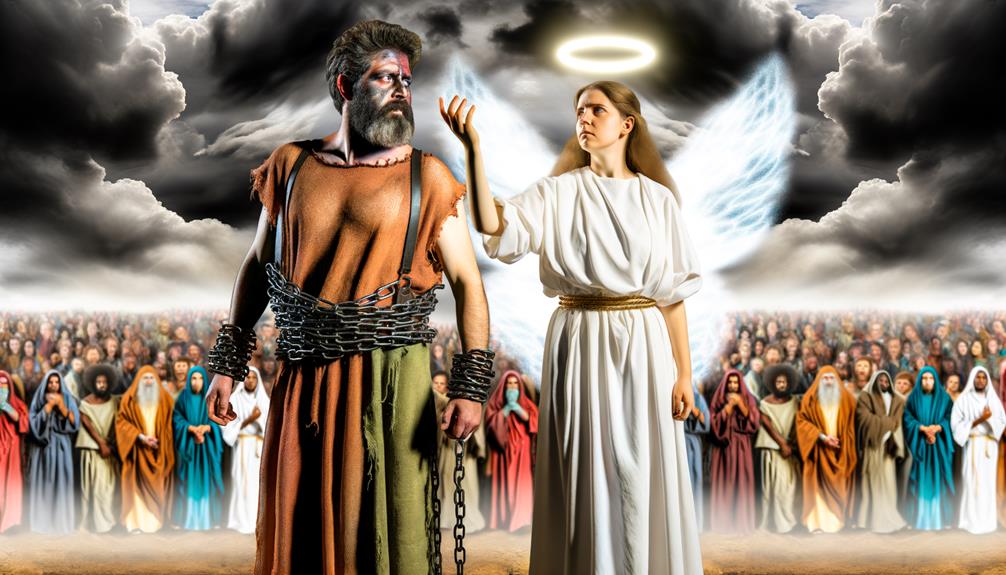
Meaning of Barabbas in the Bible: Symbol of Choice and Redemption
| Aspect | Meaning |
|---|---|
| Name | Barabbas |
| Biblical Reference | Mentioned in all four Gospels (e.g., Matthew 27:16–26) |
| Name Meaning | “Son of the father” (Bar-Abba in Aramaic) |
| Role in Scripture | A prisoner released instead of Jesus at the Passover |
| Spiritual Symbolism | Represents humanity’s sin being pardoned while Jesus takes the punishment |
| Faith Insight | Highlights the power of God’s grace and the cost of our redemption |
Historical Background of Barabbas
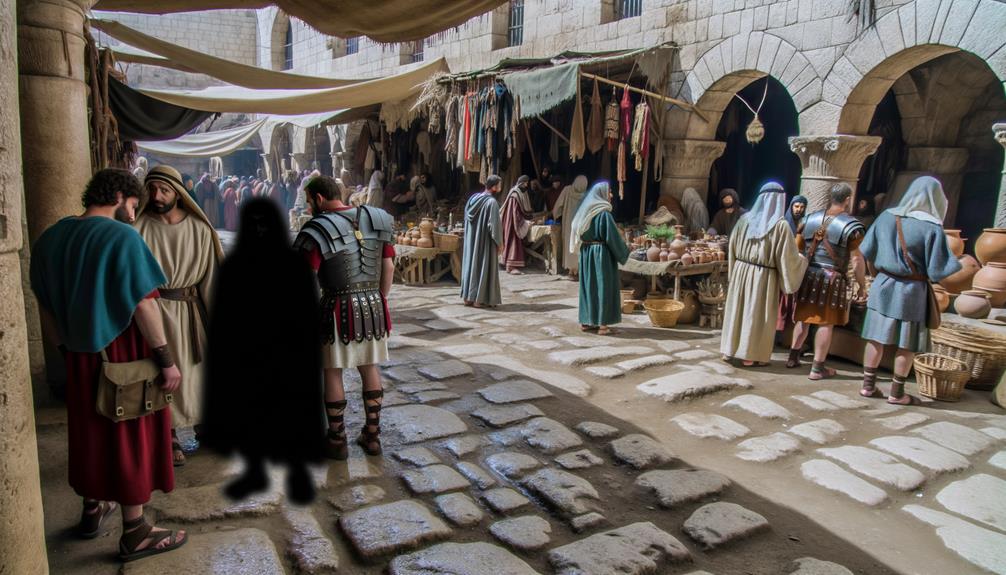
Barabbas, a figure mentioned in the New scripture, is historically significant as the prisoner whom the crowd chose to release instead of Jesus Christ, highlighting the political and social tensions of Roman-occupied Judea.
His release, as per tradition during Passover, underscores the volatile atmosphere wherein Roman authorities attempted to placate Jewish unrest.
Barabbas is often identified as an insurrectionist, possibly affiliated with the Zealots, a group vehemently opposed to Roman rule. This situates him within the broader context of Jewish resistance against Roman oppression.
Understanding Barabbas‘s historical background provides insight into the complexities of Judean society, where political rebellion and messianic expectations intertwined, creating a backdrop for the pivotal events surrounding Jesus’s crucifixion.
Barabbas in the Gospels
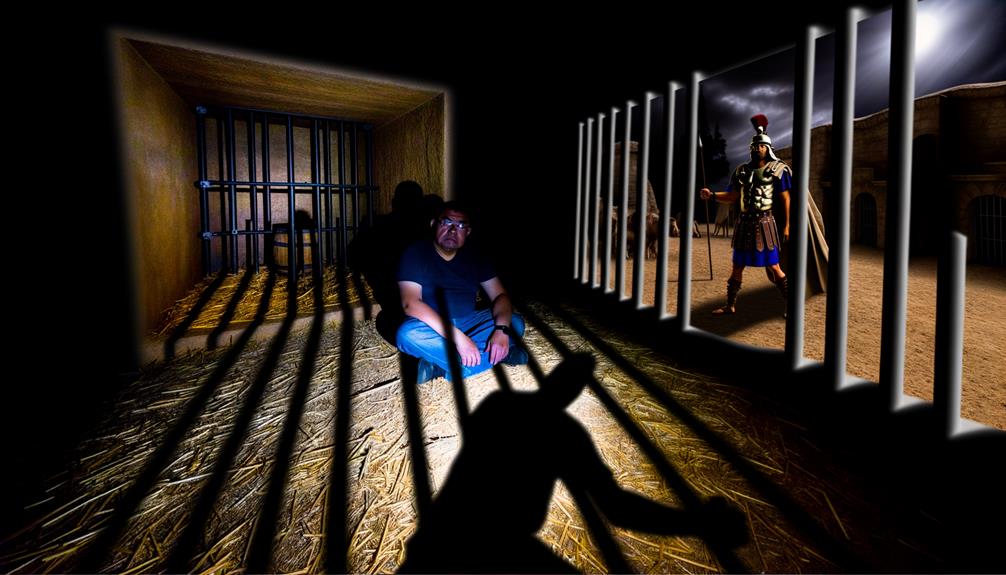
In each of the Gospels, the account of Barabbas’ release by Pontius Pilate highlights a pivotal moment of public decision-making and moral contrast.
The crowd’s choice to free Barabbas, a known insurrectionist, over Jesus, who was proclaimed innocent, underscores the theological significance of substitution and redemption central to Christian doctrine.
This narrative moment not only provides insight into the socio-political dynamics of the time but also serves as a profound reflection on human nature and divine justice.
Barabbas’ Release by Pilate
Pilate’s decision to release Barabbas, as depicted in the Gospels, serves as a pivotal moment that underscores the political and social tensions of the time, as well as the deep theological implications of Jesus’ crucifixion.
This event highlights the Roman authority’s attempts to placate an increasingly volatile populace while inadvertently fulfilling prophetic scripture. Barabbas, described as a notorious prisoner, symbolizes the embodiment of insurrection against Roman rule.
- Political Maneuvering: Pilate’s act reflects the delicate balance he sought to maintain between Roman authority and Jewish unrest.
- Theological Symbolism: The release of Barabbas instead of Jesus illuminates the sacrificial nature of Jesus’ mission.
This intricate narrative layer invites profound reflection.
Crowd Chooses Barabbas
The Gospel accounts collectively depict the momentous scene where the crowd, swayed by religious leaders, clamors for Barabbas’ release, thereby highlighting the stark contrast between human justice and divine providence.
Historically, Barabbas was a notorious prisoner, likely involved in insurrection against Roman rule.
Theologically, the crowd’s choice represents a profound irony: they preferred a known criminal over Jesus, the embodiment of innocence and divine truth.
This episode underscores the fickle nature of public opinion and the manipulative power of religious elites.
In addition, it foreshadows the sacrificial role of Christ, as the innocent suffers while the guilty goes free, embodying the concept of substitutionary atonement central to Christian theology.
The Name ‘Barabbas’

Exploring the etymology of the name ‘Barabbas’ reveals its Aramaic roots, where ‘Bar’ means ‘son’ and ‘Abba’ means ‘father’ or ‘teacher’, consequently translating to ‘son of the father’. This nomenclature carries profound implications within the biblical narrative.
- Historical Context: The name ‘Barabbas’ was likely a common one, reflecting familial lineage and societal roles.
- Theological Insight: The juxtaposition of Barabbas, ‘son of the father’, with Jesus, the Son of God, offers a poignant theological dichotomy.
This rich etymology enhances our understanding of his role and significance in biblical history.
Barabbas and Jesus: A Contrast
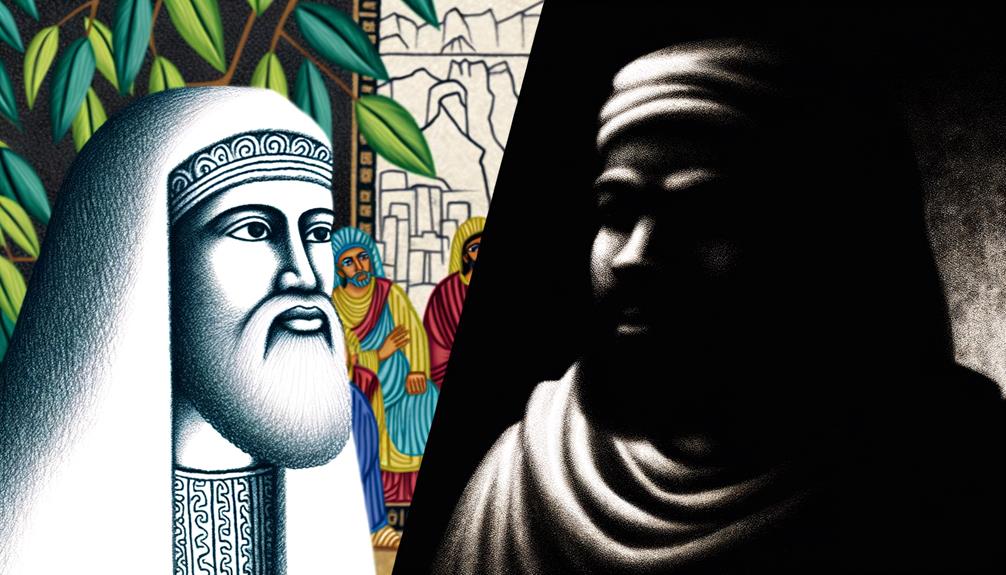
Juxtaposing Barabbas and Jesus within the biblical narrative illuminates the stark contrast between the paths of rebellion and redemption.
Barabbas, a known insurrectionist, symbolizes violent resistance against Roman rule, embodying the human inclination towards forceful upheaval. In contrast, Jesus represents a path of peace and sacrificial love, offering redemption through selflessness.
Historically, the choice presented to the crowd—release Barabbas or Jesus—highlights the divergent ways people sought liberation: Barabbas through militant action, Jesus through spiritual salvation.
Theologically, Barabbas’s freedom and Jesus’s crucifixion underscore a profound exchange of guilt for innocence.
This juxtaposition not only underscores different responses to oppression but also invites reflection on the deeper spiritual meanings of justice and deliverance within the Christian faith.
Theological Implications
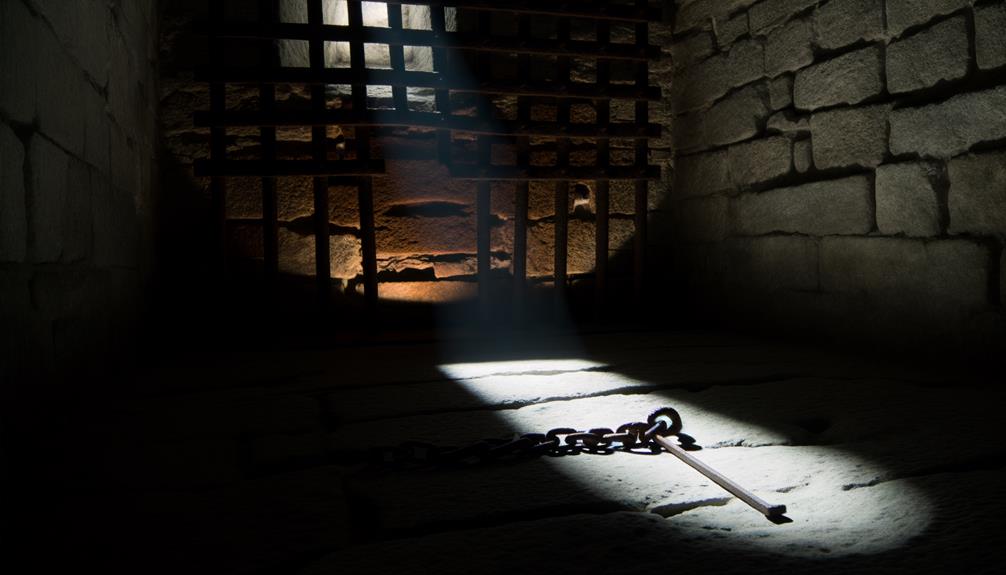
The release of Barabbas in place of Jesus presents profound theological implications, particularly regarding the concepts of substitution and redemption.
Historically, Barabbas serves as a symbol of humanity, whose freedom is purchased through the sacrificial act of Christ.
This narrative underscores the foundational Christian belief that redemption is achieved through the atonement and the ultimate sacrifice of Jesus.
Symbol of Substitution
Barabbas, whose release was chosen over that of Jesus, serves as a profound symbol of substitution in Christian theology, illustrating the concept of an innocent life being exchanged for the guilty. This event underscores several key theological insights:
- Divine Justice and Mercy: The release of Barabbas highlights the dual nature of God’s judgment—upholding justice while extending mercy through Jesus’ sacrifice.
- Human Choice and Divine Plan: The crowd’s choice reflects human agency within God’s sovereign plan, emphasizing the foreordained substitution of Christ for humanity.
- Symbolic Representation: Barabbas, whose name means ‘son of the father,’ paradoxically contrasts with Jesus, the true Son of the Father, symbolizing the exchange of true innocence for human sinfulness.
This pivotal moment encapsulates the essence of substitutionary atonement.
Redemption Through Sacrifice
Understanding Barabbas’ release as a symbol of substitution deepens the theological implications of redemption through Christ’s ultimate sacrifice.
Historically, the choice between Barabbas and Jesus underscores the concept of an innocent life being exchanged for a guilty one. This substitution mirrors the Old Covenant sacrificial system, where a lamb would bear the sins of the people.
In theological terms, Jesus’ acceptance of crucifixion, while Barabbas—a known criminal—was set free, epitomizes the grace and mercy inherent in divine redemption. This act signifies that humanity, represented by Barabbas, is spared from condemnation through Christ’s atoning sacrifice.
Consequently, the narrative of Barabbas illuminates the profound depths of Christ’s redemptive work, offering believers a tangible representation of salvation and grace.
Symbolism and Irony

In contemplating the symbolism and irony surrounding Barabbas in the biblical narrative, one must consider the profound juxtaposition between Barabbas, a known insurrectionist, and Jesus Christ, who is presented as the innocent savior. This contrast highlights the moral and theological implications of the crowd’s choice to free Barabbas over Jesus. The irony lies in the fact that the crowd chose a man guilty of rebellion while condemning an innocent man who preached peace and redemption.
Barabbas represents the flawed nature of human judgment and the susceptibility to mob mentality. Jesus, the true savior, takes the place of a criminal, emphasizing the concept of atonement.
The choice reflects the complex dynamics between Roman authority and Jewish expectations of a Messiah.
Modern Interpretations

Modern interpretations of Barabbas often explore his role through the lenses of historical context, theological significance, and psychological analysis, offering a multifaceted understanding of his character in the biblical narrative.
Historically, Barabbas is viewed as a political insurgent, representing the Jewish struggle against Roman occupation.
Theologically, his release over Jesus highlights themes of substitutionary atonement, illustrating the concept of the innocent suffering for the guilty.
Psychologically, Barabbas can be seen as a figure embodying the human condition, caught between redemption and rebellion.
Contemporary scholars also investigate the socio-political implications of the crowd’s choice, examining how public opinion and authority dynamics are portrayed.
This layered approach enriches the modern comprehension of Barabbas’ role in Scripture.
Conclusion
The narrative of Barabbas, steeped in historical and theological layers, underscores profound contrasts and ironies.
The name ‘Barabbas,’ translating to ‘son of the father,’ juxtaposes the innocent Christ, the true Son of the Father, highlighting the depths of human fallibility and divine grace.
This exchange, laden with symbolic meaning, provides a poignant reflection on justice, redemption, and the choices faced by humanity.
Modern interpretations continue to unravel these themes, offering inexhaustible avenues for contemplation and discourse.






